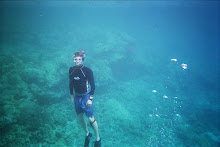Light in diving is somehow illustrated by a cathedral: for the first few metres where the windows are there is colour, but the floor below is in shade, though there is still quite enough light and one can read if one wants. The explanation of the gradual disappearance of colour underwater is, of course, that as the sun's rays diminish with increasing depth, so the world goes into monochrome. Red disappears first, after about 15 metres, yellow is the last to go at about 30. I discovered this for myself when I cut my finger at 50 metres. My blood oozed out black as ink, and when I looked at my nail varnish it was black too. I can now gauge the depth at which I happen to be swimming by the colour of my nails. (7)
and
Curiously enough, I had less difficulty in equipping myself for underwater drawing than John had had on land. Lead pencils work underwater and so do india-rubbers. Any sheet of light-coloured metal, such as aluminium, makes a serviceable tablet. Notes and drawing made in the water are traced on to paper later, so that a tablet can be re-used. When I do not have to improvise, my standard equipment consists of a portable metal drawing-board with a spring clamp down one side, such as architects use in the field. Sheets of plastic "paper", cut to size, are inserted in the spring to form a block; they can be detached after use. The only modification that had to be made to this portable board was the addition of a second clamp, held by bolts, on the opposite side of the board. Without this, the sheets tended to slip out of the spring when submerged. Plastic or metal rulers are equally serviceable in water, but for longer measurements I find that an arrow from my fish-gun (graduated in units of 10 centimetres in nail varnish) is handier. It is also less likely to be mislaid on a boat, where fish-guns are always carefully stowed. (172)
I'm always trying to match books and readers, and I do like to share the books I value, but I have yet to find another proper reader for Frost's semi-autobiographical study of the essential problems in the proper approach to understanding archaeologically marine sites and remains. The level of expertise may have been superseded, particularly with the advent of more refined technology and diving experience being embraced by serious scientists, but the comprehension of and the appreciation for the underlying issues remain timeless.



















